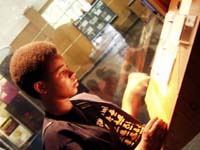WFU Sociology class returns from journey through Deep South

Davonda Burton at a civil rights site in Atlanta.
This summer, while following the paths of civil rights history through the Deep South, Wake Forest University sociology students explored present-day social inequalities.
From Atlanta to the Mississippi Delta, 15 students enrolled in a three–credit course traveled by bus to cities, towns and rural areas in five southern states. The students were on the road from July 28 to Aug. 8.
The class, Social Stratification in the American Deep South, was designed by Earl Smith, chairman of the sociology department at Wake Forest, and Angela Hattery, associate professor of sociology, to help students better understand social, economic and political issues in the South.
For more details about the trip, including photographs and journal entries from students, see the class Web site.
The bus was a high-tech rolling classroom with a full complement of audio-visual equipment and a horseshoe-shaped seating area set up for seminars on the go.
The two Wake Forest professors coordinated lectures, documentaries, statistical information and other course materials with visits to places like Tunica County, Miss., among the poorest counties in the country’s poorest state, and Montgomery, Ala., home of the Southern Poverty Law Center.
“The goals of the course are to show students, via a lived experience, how stratification unfolds in the American South and to show that America is not a classless society,” said Smith, who also directs the American Ethnic Studies program at Wake Forest.
Using civil rights sites as a roadmap, the class stopped in Birmingham, Ala., to visit the 16th Street Baptist Church. While there, the students met with several Birmingham residents who were involved in the Civil Rights Movement in the 1960s.
The bus also stopped at Selma and Tuskegee. Then the students crossed into Mississippi making stops in Hattiesburg, Greenwood, Clarksdale and a handful of other places.
The professors used these important places from the past as a springboard for an examination of current imbalances between rich and poor, black and white. The journey allowed the students to reflect upon not only the milestones of the civil rights movement, but also contemporary social class structure in areas such as housing, employment opportunities, education and criminal justice.
Students created demographic profiles of the communities they visited with data from the 2000 U.S. Census and other sources. Laptop computers allowed the students to access and present information while they are on the road. Students also used their laptops to plot maps of social inequality, create charts showing marriage and housing patterns, and chart industry and employment for the communities they visited.
To explore issues related to “southern justice,” the students spent a day at the Mississippi State Penitentiary at Parchman. At Parchman, the students talked with inmates and prison officials.
The prison population is 80-90 percent black in a state that is only 40 percent black, Hattery said. “One-third of the state’s blacks spend time in Parchman, so the prison shapes the lives of people who live in Mississippi in profound ways.”
As part of the journey, the students volunteered for a day in New Orleans at the Café Reconcile, a community restaurant that trains low-income people for jobs in the hospitality industry.
In many communities, the class met with local ministers, civil rights activists and workers at social service agencies and mingled with ordinary citizens as much as possible to learn about day-to-day life in the South.
Categories: Experiential Learning, Research & Discovery
Media Contact
Cheryl Walker
media@wfu.edu
336.758.5237



